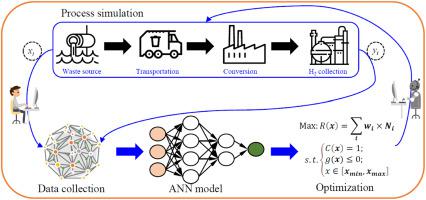当前位置:
X-MOL 学术
›
Biomass Bioenergy
›
论文详情
Our official English website, www.x-mol.net, welcomes your feedback! (Note: you will need to create a separate account there.)
Novel process optimization based on machine learning: A study on biohydrogen production from waste resources
Biomass & Bioenergy ( IF 5.8 ) Pub Date : 2024-04-30 , DOI: 10.1016/j.biombioe.2024.107222 Tao Shi , Jianzhao Zhou , Yousaf Ayub , Sara Toniolo , Jingzheng Ren
Biomass & Bioenergy ( IF 5.8 ) Pub Date : 2024-04-30 , DOI: 10.1016/j.biombioe.2024.107222 Tao Shi , Jianzhao Zhou , Yousaf Ayub , Sara Toniolo , Jingzheng Ren

|
The biomass poultry litter and sewage sludge co-gasification is a good thermochemical method to produce hydrogen energy meanwhile to mitigate the consumption of fossil fuels. However, the operation optimization in the complex process system is important while computationally difficult because of high nonlinearity and many first-principle constraints. To address the optimization of this biohydrogen production process, a methodology framework for achieving the optimal operations is thus presented. The complete process system is first simulated and decomposed into upstream gasification process and downstream hydrogen purification for reducing computational complexity through the thermodynamic equilibrium-based simulation. Totally 1400 data points by pairing total 15 operating conditions with a composite sustainability index objective are generated through the random sampling and data classification strategies, which are then used for the construction of the artificial neural network (ANN)-based prediction models. ANN models of two subprocesses demonstrate the satisfactory prediction accuracy with R value of 0.98 and 0.99, respectively, which are then integrated with mixed-integer linear programming (MILP) for the optimization of upstream process and downstream process step-by-step. The MILP problems based on the ANN models are solved with lower optimization time of 45∼100 s compared to the heuristic algorithm optimization (3–6 h) based on the thermodynamic equilibrium-based simulation. The optimal sustainability index values of two processes are 0.80 and 0.91 which are both improved compared to the existing optimization results (0.79 and 0.84). This study emphasizes the optimization potential of the integration approach of machine learning-based modelling and mathematical programming for developing the optimal waste-to-energy processes.
中文翻译:

基于机器学习的新型工艺优化:废物资源制生物氢研究
生物质家禽粪便和污水污泥共气化是一种很好的热化学方法来生产氢能,同时减少化石燃料的消耗。然而,复杂过程系统中的操作优化很重要,但由于高度非线性和许多第一性原理约束而导致计算困难。为了解决生物氢生产过程的优化问题,提出了实现最佳操作的方法框架。首先对完整的工艺系统进行模拟,并将其分解为上游气化过程和下游氢气纯化过程,以通过基于热力学平衡的模拟来降低计算复杂性。通过随机抽样和数据分类策略,将总共 15 个操作条件与综合可持续性指数目标配对,生成总共 1400 个数据点,然后将其用于构建基于人工神经网络 (ANN) 的预测模型。两个子过程的ANN模型表现出令人满意的预测精度,R值分别为0.98和0.99,然后将其与混合整数线性规划(MILP)集成以逐步优化上游过程和下游过程。与基于热力学平衡模拟的启发式算法优化(3-6 小时)相比,基于 ANN 模型的 MILP 问题的求解时间较短,为 45∼100 秒。两个流程的最优可持续性指数值为0.80和0.91,与现有优化结果(0.79和0.84)相比均有所提高。 这项研究强调了基于机器学习的建模和数学编程的集成方法在开发最佳废物转化能源过程方面的优化潜力。
更新日期:2024-04-30
中文翻译:

基于机器学习的新型工艺优化:废物资源制生物氢研究
生物质家禽粪便和污水污泥共气化是一种很好的热化学方法来生产氢能,同时减少化石燃料的消耗。然而,复杂过程系统中的操作优化很重要,但由于高度非线性和许多第一性原理约束而导致计算困难。为了解决生物氢生产过程的优化问题,提出了实现最佳操作的方法框架。首先对完整的工艺系统进行模拟,并将其分解为上游气化过程和下游氢气纯化过程,以通过基于热力学平衡的模拟来降低计算复杂性。通过随机抽样和数据分类策略,将总共 15 个操作条件与综合可持续性指数目标配对,生成总共 1400 个数据点,然后将其用于构建基于人工神经网络 (ANN) 的预测模型。两个子过程的ANN模型表现出令人满意的预测精度,R值分别为0.98和0.99,然后将其与混合整数线性规划(MILP)集成以逐步优化上游过程和下游过程。与基于热力学平衡模拟的启发式算法优化(3-6 小时)相比,基于 ANN 模型的 MILP 问题的求解时间较短,为 45∼100 秒。两个流程的最优可持续性指数值为0.80和0.91,与现有优化结果(0.79和0.84)相比均有所提高。 这项研究强调了基于机器学习的建模和数学编程的集成方法在开发最佳废物转化能源过程方面的优化潜力。
















































 京公网安备 11010802027423号
京公网安备 11010802027423号